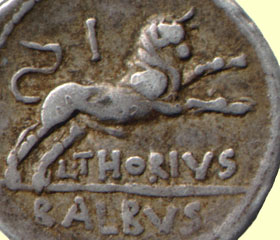 The letter for the vowel U is shaped like the modern letter V in the inscription on this Roman denarius from the Republican period. This, and the fact that there was neither a J nor a W in the original Roman alphabet, are the only differences between their alphabet and ours after over 2000 years. The artistic style of lettering varied quite a bit during different periods as it still does today, often leading the unwary scholar to believe that the letters themselves were different.
The letter for the vowel U is shaped like the modern letter V in the inscription on this Roman denarius from the Republican period. This, and the fact that there was neither a J nor a W in the original Roman alphabet, are the only differences between their alphabet and ours after over 2000 years. The artistic style of lettering varied quite a bit during different periods as it still does today, often leading the unwary scholar to believe that the letters themselves were different.
Ancient civilizations made the discovery that ideas could be represented by standard symbols that could be written down, painted on a surface, or pressed into wet clay somewhere between 5000 and 6000 years ago. The Sumerians used a stick whose cross section had either three or four sides to write their cuneiform letters on moist clay tablets that were later baked. Later, the Egyptians and Greeks used a mallet and chisel to write on stone and a reed pen to write on papyrus and specially scraped and prepared cow and sheep skins. Hieroglyphs were pictorial symbols of objects and animals from the Egyptian’s everyday life. They were often richly detailed and painted by the writer. It was important to the Egyptians that their written language was beautiful and the symbols were grouped in an arrangement pleasing to the eye. Their order was quite flexible and they could be read from right to left, left to right, and from top to bottom. The Greeks inherited their alphabet from one brought to their islands by Phoenician traders. By this time, many of the letters they used were ones we would recognize today and some even had the same sounds associated with them. The Roman alphabet was derived largely from the Greek and was almost the same as the one we use today. There are some important differences, though, that can cause a lot of confusion for someone who wishes to casually study the language or read coin inscriptions.
First, the modern reader will notice that the Romans wrote only in uppercase or capital letters with beautifully proportioned straight lines, curves, and angles until quite late in their history. In fact, the uncials or lower case letters were a medieval invention and are seen beginning in the Fifth and Sixth Centuries, with a few examples dating a little earlier. Good examples of the fine style of Roman capital letters can be seen in the inscriptions carved with mallet and chisel into stone monuments.
In addition, there was no "J" in ancient Latin and the "U" was seldom seen and usually follows a "V" . The Romans wrote an "I" where we might write a "J" and pronounced it as a consonant with a "yuh" sound in these places. The "V" stood for our "U" and made a "W" sound where we might make the "V" sound reading the word in modern English. Below are some Latin words and how we might write the word in English. The third column shows how most Romans probably pronounced the word. Remember, the Roman Empire was a vast, diverse empire and regional variations in pronunciation abounded.
| Latin Spelling | English Spelling | English Pronunciation |
| MAIOR | major | mayor |
| IVVENAL | Juvenal | Yoovenal |
| PECVNIA | pecunia | pecunia |
| IVLIA | Julia | Yoolia |
| IVSTINIANVS | Justinian | Yustinianus |
Though the inscriptions on stone monuments were usually impeccably neat, the ones found on coins ranged from beautifully proportioned to abysmally sloppy. It often depended on how much care the ancient celator or die maker put into his work.. Also, when the coins were struck, they were sometimes near melting temperature and the letters seem like they have begun to flow or have been pulled along the surface of the coin. Often you will find greatly exaggerated serifs, the pointed finishing touches that adorned the ends of the strokes (the highly flared ends of the arms of an "X" , for example).
Go to next article:
Go back to previous article: